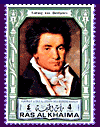
In February, Dr. George Hardman published The Philatelic Beethoven, a nicely presented book in plastic spiral binding with an evocative cover that speaks much to those who have Beethoven collections. The book contains 10 previously-published essays through which Hardman explores some ordinary but exciting features of 'the Titan' on stamps.
Each essay has much, not only for stamp collectors, but also for those who would better appreciate Beethoven's music. "Women on Stamps" was particularly impressive on "many young, pretty women" of Beethoven's lifetime who have themselves been the subjects of stamps. The topic and the information expands the range of Beethoven philately.
Hardman's contribution on the famed Chagall Peace Window at the United Nations acknowledges a very curious puzzle, but he uses the triptych of Ludwig van Beethoven, Dag Hammarskjold, and Marc Chagall to give understanding to this "intriguing philatelic linkage." The theme of the item is love and Hardman aptly writes: "One took the pen and the lines danced. Another seized the flute and the notes shimmered. A third grasped the brush and the colors sang."
Another feature in The Philatelic Beethoven reviews Beethoven Sonatas, five of which "have been accorded philatelic recognition." Piano sonata 14, for example, appears on nine stamps and one label while the obscure Opus 28 is on two stamps. A most celebrated Beethoven philatelic item is Germany's 1959 souvenir sheet issued to mark the opening of Beethoven Hall at Bonn. One other Beethoven masterpiece that gets the author's thorough attention is the famed Missa Solemnis which has had much philatelic attraction.
George Hardman's The Philatelic Beethoven has numerous black and white illustrations depicting many of the over 200 Beethoven stamps and souvenir sheets, and each essay has its own extensive bibliography. Of much interest and value is a musical glossary which enables the collector to move more comfortably through the wonderment of classical music, and Hardman adds a master checklist of Beethoven stamps and postal stationery. The checklist employs Michel Katalog numbers because Hardman was unable to make arrangements with Scott to use their numbering system.
The Philatelic Beethoven is a remarkable personal undertaking from which a great number of collectors will draw much information and pleasure. It extends an appreciation of the classical composers, and the scholar Hardman gives the work validity because of his expertise with both stamps and music. The Philatelic Beethoven would satisfy the maestro himself, and he was not easily pleased.
Copies of The Philatelic Beethoven are available from Dr. George Hardman, 1148 Belleview Road, McLean, VA 22102-1104 - $15 postpaid in the U.S.
Michael O. Nowlan was born in Chatham, New Brunswick Canada. He grew up on a nearby farm, was educated, and became a teacher. In retirement, he follows his life-long avocation of writing. His credits include 16 books (four books of poems, two children's titles, and anthologies for schools). In recent years, he has written extensively about stamp collecting for CANADIAN STAMP NEWS, GIBBONS INTERNATIONAL STAMP NEWS, and other philatelic publications.